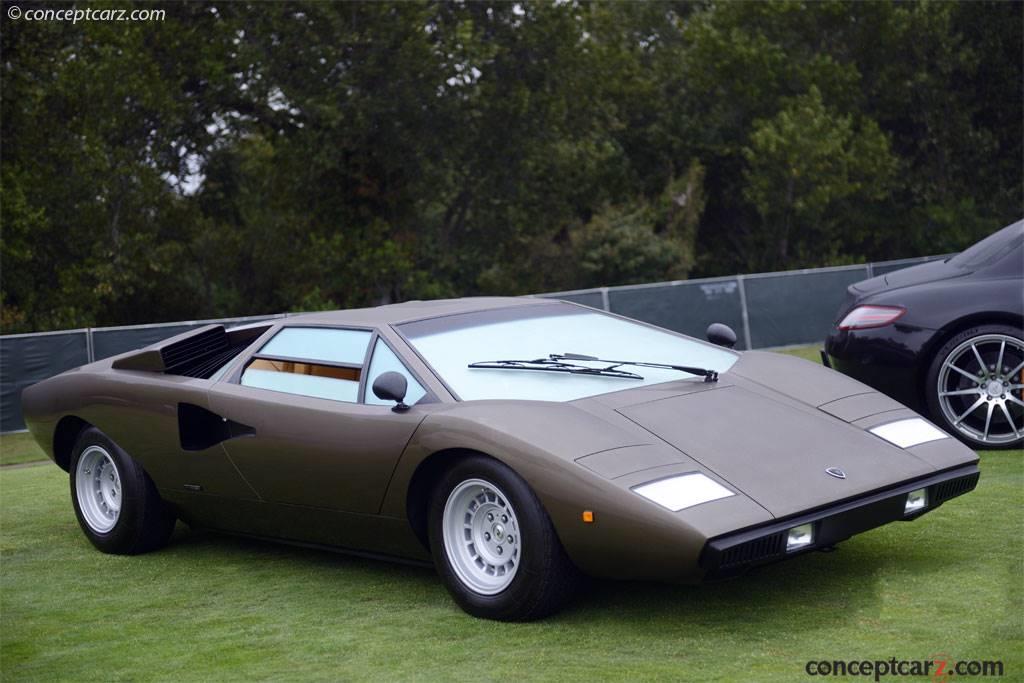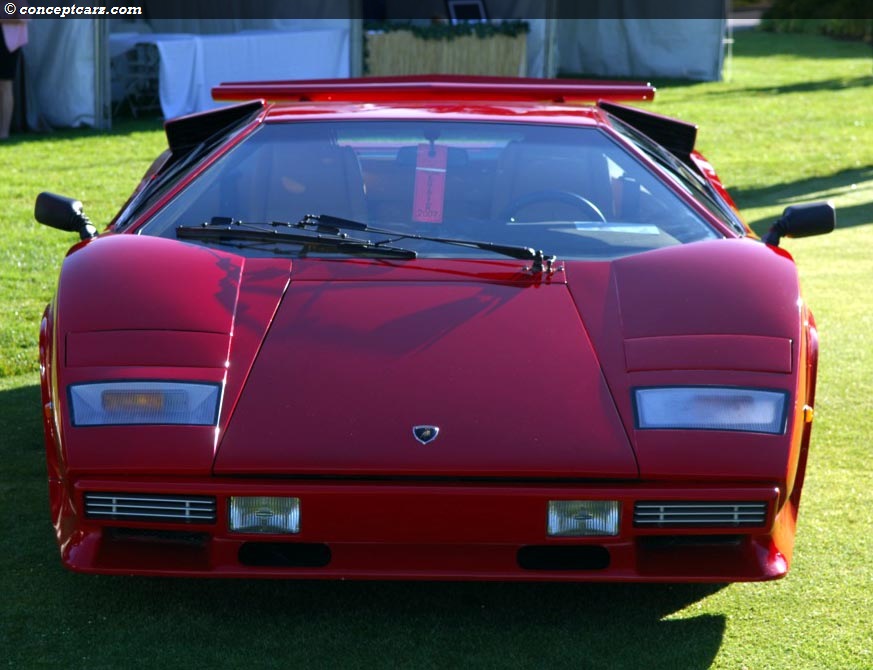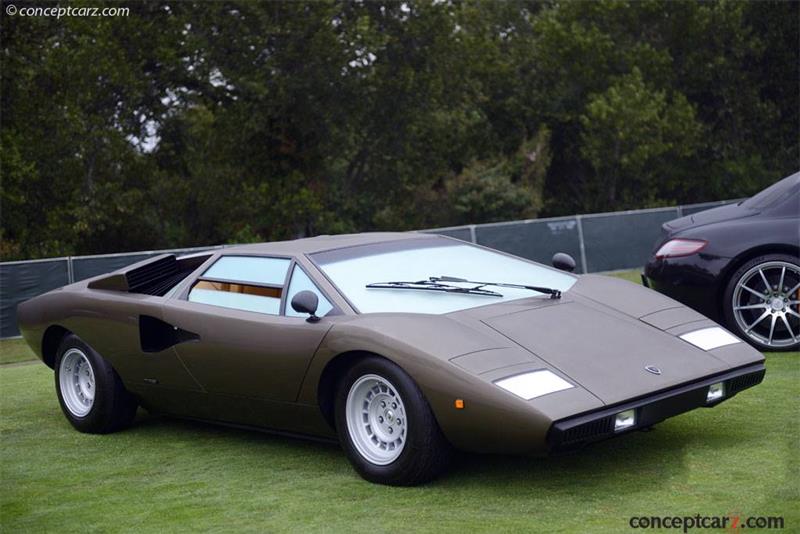The Lamborghini Countach had a profound and influential impact on the automotive industry and while most sports cars wore voluptuous, curvaceous, and feminine bodylines, the Countach was aggressive, angular, and brash. It burst onto the scene in 1971 at the Geneva Motor Show wearing a design by Marcello Gandini of Bertone. 
Coupe
Chassis #: 1120298
View info and historyThe Countach was the successor to the Miura which had been widely acclaimed at its introduction in 1966. In 1970, chief engineer Paolo Stanzani and his staff began working on the Miura's successor under the project name 'LP112.' Although Mr. Ferruccio Lamborghini preferred comfortable grand tourers, he understood the commercial value of an uncompromising sports car which had been proven by the popularity and success of the Miura. Unconstrained by user-friendliness or ergonomics, Gandini's design for the Countach was impossibly low, wide, and angular. The mid-mounted V-12 engine, forward-located cabins, and scissor door arrangement of the Diablo, Murciélago, and Aventador can all trace their origins to Gandini's Countach. Several design cues from the Miura were incorporated into the resulting Countach, including the rear mid-engine, rear-wheel drive layout. Shortcoming of the Miura was addressed, improving the limited maintenance access, cooling issues, uneven weight distribution, lack of stability at high speeds, and reducing lift-off oversteer. Although the Miura had already pioneered a mid-engined V-12 layout, the Countach engineering team chose to take the concept one step further and installed the engine longitudinally. Additionally, they managed to mid-mount the transmission by moving the output shaft to the front of the engine rather than the rear. Drive was then channeled via a prop shaft that ran through the engine's oil sump to a rear differential and through to the rear wheels. This arrangement resulted in increased stability by keeping mass in the center of the car, and allowed the gear linkage to be shortened, thus improving its action, whilst also permitting far easier access to engine ancillaries for servicing and maintenance.The Prototype Countach was 158-inches long, 73-inches wide, and 41 inches tall, while the production LP400 was slightly larger at 74-inches wide, 42 inches tall, and 163 inches long. The prototype example was devoid of bumpers, side mirrors, and aerodynamic spoilers. Trapezoidal shapes were used throughout the body, including the side windows, windshield, hood, door openings, taillights, and engine covers. Side-mounted radiators distributed air to the engine via louvered vents located just behind the side windows. Through testing, it was quickly discovered that these vents alone were unable to provide adequate cooling for the engine. NACA ducts were later added, spanning the doors and rear wings on each side, and the louvered vents were replaced by protruding air intake boxes. Excessive front-end downforce was reduced by altering the sloping of the nose, and the horizontally split two-piece windows replaced the small trapezoidal glass sections on the side windows. Along with small windows added behind the side windows, rearward visibility improved. 
CoupeThe prototype had used a futuristic dashboard and diagnostic display, but the production version used a conventionally styled dashboard using Stewart-Warner analog gauges. The single-spoke steering wheel used on the prototype was replaced by a three-spoke wheel that was similarly styled to other production Lamborghini vehicles. The LP400 used the periscope rear-view mirror, but subsequent models used conventional rearview mirrors.Chassis
The original prototype Countach used an all-steel partial space frame chassis, using both a steel sheet and square-section steel tubing. The second prototype and production versions followed a similar design and layout, but the steel sheet and square tube construction were disregarded, replaced in favor of a full space frame constructed of welded round-section steel tubing. It was both stiffer and weighed less than the original design, offering additional performance benefits. The downside was that it was more labor intensive and required more hand-welding. Both the prototype and production bodies were constructed primarily of unstressed aluminum panels, with the production versions using slightly thicker panels than the prototypes. A separate fiberglass and aluminum panel was installed underneath the passenger compartment, serving as the floor panel. The LP400 had an all-aluminum body while the bodies of later Countach models were made of fiberglass and carbon composites. Engine
The twelve-cylinder engine powering the Countach was designed by Giotto Bizzarrini and originated in 1963. Preceding and currently produced Lamborghini models equipped with versions of this engine included the 350 GT, 400 GT, Islero, Espada, and Miura. The V12 configuration powering the Miura displaced 3,929cc's and had two valves per cylinder, double overhead camshafts per bank, a 60-degree cylinder bank angle, and distributor ignition. 3.9-liter and 5.0-liter displacement sizes were considered. The larger displacement would allow for higher horsepower outputs and reduce usability issues. An LP500 prototype was tested using a bored-out 3.9-liter engine block with many lightweight castings made from Elektron. During a road test in 1971 by Bob Wallace, the engine was destroyed, prompting further work to improve durability. For the remainder of pre-production testing, the LP500 prototype was later fitted with a 3.9-liter engine. The early production examples came equipped with the 3.9-liter engine as the new 5-liter engine still suffered from durability issues.The Countach LP400 of 1974 used side-draft Weber 45 DCOE carburetors and produced 370 horsepower at 8,000 rpm, less than the output of the Miura SV (which had used down-draft carburetors). The 1982 Countach LP500S had a larger 4,754cc displacement, and the 1985 LP5000 Quattrovalvole had a 5,167cc displacement and four valves per cylinder. Common to all the versions were six Weber carburetors until the LP5000 QV, some of which received Bosch K-Jetronic fuel injection to comply with U.S. emission regulations. The European-specification cars continued to use carburetors. Recent Lamborghinis have been named after bulls or bullfighting, but the word Countach, however, has its origins as a phrase used by Piedmontese men to describe the moment of laying eyes on a beautiful woman. Its application to Lamborghini's latest supercar was no doubt appropriate, as few cars have caused such a stir in the automotive world.
Following extensive development and testing, the first Countach prototype, designated LP500, made its debut in 1971 at the Geneva Motor Show. The production-ready version, known as the LP400 Countach, arrived in 1974 following three years of further refinement. Four years later, the company introduced the second variant of the model, the LP400S. This model added wider Pirelli tires that were covered in muscular but subtle arches. Three distinct series of LP400S were produced, with the first two series retaining ground-hugging low suspension and much of Gandini's original design. The initial Series I, a limited run of 50 cars, was equipped with the Campagnolo Bravo wheels which were nicknamed 'telephone dials' by enthusiasts.
CoupeAlong with the wedge-shaped design, the scissor doors were among the most prominent design features of the Countach. Scissor doors had first been used on Gandini's 1968 Alfa Romeo Carabo concept car, lifting the doors up and tilting forward when opened. Its use on the Countach was both a styling feature and a solution for easier entry and exit from the vehicle. The wide chassis and high and wide doorsills made the use of conventional doors a problem in narrow spaces. LP 400 S
Lamborgini introduced the new LP400 S in 1978. Among the changes were 345/35R15 Pirelli P7 tires - the widest tires available on a production car at the time. Fiberglass wheel arch extensions were added to accommodate the width of the tires. With the wide tires in place, the LP400 S's handling was improved and made the car more stable while cornering. The addition of an optional V-shaped rear wing over the rear deck improved high-speed stability, but it also reduced the top speed by at least ten miles per hour. The engine's output was slightly reduced from the LP400 and now delivered 350 horsepower. The standard emblems of 'Lamborghini' and 'Countach' remained at the rear, but an angular 'S' emblem was added after the 'Countach on the right side. The LP400 S series was produced in three 'series,' with fifty examples of the 'Series One,' 105 of the 'Series Two,' and 82 of the 'Series Three.' Series 1 cars had a lowered suspension, 45mm carburetors, and Campagnolo 'Bravo' wheels with protruding hole edges. Early examples had small Stewart-Warner dashboard gauges, while versions built halfway through 1979 incorporated larger gauges. Early 1978 cars had the LP400 steering wheel, while later cars received a padded-style wheel.
CoupeSeries Two cars had smoother, concave wheels and lowered suspension ride height. The Series Three cars had increased suspension ride height and slightly more usable interior space. The final chassis number of Series I cars is 1121100; the final Series II car is chassis number 1121310, and the first of the Series III cars is 1121312 (the final is 1121468). Lamborghini enlarged the engine in 1982, to 4,754cc, resulting in the LP500 S. Minor updates were made to the interior, and 321 examples were built.In 1985, the displacement grew to 5,167cc and the engine received four valves per cylinder (quattrovalvole). The 25th Anniversary Countach arrived in 1988 and was mechanically similar to the 5000QV. Styling revisions were courtesy of Horacio Pagani. Lamborghini produced 610 examples of the 5000QV and 657 of the 25th Anniversary. A total of 1,983 cars were built during the Countach's sixteen-year lifetime.The angular styling of the Countach defined the language for nearly every supercar since. The company has remained true to the Countach's original design over the past 45 years, with many of the influences still seen today in the current models, including the Aventador.
by Daniel Vaughan | Aug 2021

Coupe
Chassis #: 1120298
View info and history

Coupe
The original prototype Countach used an all-steel partial space frame chassis, using both a steel sheet and square-section steel tubing. The second prototype and production versions followed a similar design and layout, but the steel sheet and square tube construction were disregarded, replaced in favor of a full space frame constructed of welded round-section steel tubing. It was both stiffer and weighed less than the original design, offering additional performance benefits. The downside was that it was more labor intensive and required more hand-welding. Both the prototype and production bodies were constructed primarily of unstressed aluminum panels, with the production versions using slightly thicker panels than the prototypes. A separate fiberglass and aluminum panel was installed underneath the passenger compartment, serving as the floor panel. The LP400 had an all-aluminum body while the bodies of later Countach models were made of fiberglass and carbon composites. Engine
The twelve-cylinder engine powering the Countach was designed by Giotto Bizzarrini and originated in 1963. Preceding and currently produced Lamborghini models equipped with versions of this engine included the 350 GT, 400 GT, Islero, Espada, and Miura. The V12 configuration powering the Miura displaced 3,929cc's and had two valves per cylinder, double overhead camshafts per bank, a 60-degree cylinder bank angle, and distributor ignition. 3.9-liter and 5.0-liter displacement sizes were considered. The larger displacement would allow for higher horsepower outputs and reduce usability issues. An LP500 prototype was tested using a bored-out 3.9-liter engine block with many lightweight castings made from Elektron. During a road test in 1971 by Bob Wallace, the engine was destroyed, prompting further work to improve durability. For the remainder of pre-production testing, the LP500 prototype was later fitted with a 3.9-liter engine. The early production examples came equipped with the 3.9-liter engine as the new 5-liter engine still suffered from durability issues.The Countach LP400 of 1974 used side-draft Weber 45 DCOE carburetors and produced 370 horsepower at 8,000 rpm, less than the output of the Miura SV (which had used down-draft carburetors). The 1982 Countach LP500S had a larger 4,754cc displacement, and the 1985 LP5000 Quattrovalvole had a 5,167cc displacement and four valves per cylinder. Common to all the versions were six Weber carburetors until the LP5000 QV, some of which received Bosch K-Jetronic fuel injection to comply with U.S. emission regulations. The European-specification cars continued to use carburetors. Recent Lamborghinis have been named after bulls or bullfighting, but the word Countach, however, has its origins as a phrase used by Piedmontese men to describe the moment of laying eyes on a beautiful woman. Its application to Lamborghini's latest supercar was no doubt appropriate, as few cars have caused such a stir in the automotive world.
Following extensive development and testing, the first Countach prototype, designated LP500, made its debut in 1971 at the Geneva Motor Show. The production-ready version, known as the LP400 Countach, arrived in 1974 following three years of further refinement. Four years later, the company introduced the second variant of the model, the LP400S. This model added wider Pirelli tires that were covered in muscular but subtle arches. Three distinct series of LP400S were produced, with the first two series retaining ground-hugging low suspension and much of Gandini's original design. The initial Series I, a limited run of 50 cars, was equipped with the Campagnolo Bravo wheels which were nicknamed 'telephone dials' by enthusiasts.

Coupe
Lamborgini introduced the new LP400 S in 1978. Among the changes were 345/35R15 Pirelli P7 tires - the widest tires available on a production car at the time. Fiberglass wheel arch extensions were added to accommodate the width of the tires. With the wide tires in place, the LP400 S's handling was improved and made the car more stable while cornering. The addition of an optional V-shaped rear wing over the rear deck improved high-speed stability, but it also reduced the top speed by at least ten miles per hour. The engine's output was slightly reduced from the LP400 and now delivered 350 horsepower. The standard emblems of 'Lamborghini' and 'Countach' remained at the rear, but an angular 'S' emblem was added after the 'Countach on the right side. The LP400 S series was produced in three 'series,' with fifty examples of the 'Series One,' 105 of the 'Series Two,' and 82 of the 'Series Three.' Series 1 cars had a lowered suspension, 45mm carburetors, and Campagnolo 'Bravo' wheels with protruding hole edges. Early examples had small Stewart-Warner dashboard gauges, while versions built halfway through 1979 incorporated larger gauges. Early 1978 cars had the LP400 steering wheel, while later cars received a padded-style wheel.

Coupe
by Daniel Vaughan | Aug 2021
Related Reading : Lamborghini Countach History
The Lamborghini Countach was the predecessor to the very successful Miura, and it wore a body designed by Marcello Gandini at Bertone, with exotic mid-engine layout in a two-door coupe configuration. It featured an attractive, wedge-shaped, and angular body with elegant lines and fitted with modern mechanical components and technology. The engine was mounted longitudinally and replaced the transverse....
Continue Reading >>
Continue Reading >>
Similar Automakers
1978 Lamborghini Countach LP400S Vehicle Profiles
Recent Vehicle Additions
Performance and Specification Comparison
Price Comparison
Countach LP400S Specification Comparison by Year
Year
Production
Wheelbase
Engine
Prices
Related Automotive News

Lamborghini 350 GT returns to Geneva 60 years after its debut
Automobili Lamborghini celebrates its first production model by taking it back to the city where it was unveiled in 1964 by Ferruccio Lamborghini
In March 1964, Automobili Lamborghini was still in its infancy. Established just a few months previously,...

The legacy of the Lamborghini Countach in a video series. From the idea car, the LP 500 of 1971, to five generations spanning seventeen years
In its celebration of the 50th anniversary of the Countach, Automobili Lamborghini is launching a series of four videos on its social media channels. Every Monday they will recount the legacy of an automotive icon in an unprecedented manner, by involving...

Lamborghini Miura SV turns 50 in 2021
The Lamborghini Miura SV, the last evolution of the highly successful P400 project, was officially unveiled in March 1971, on the Lamborghini stand at the Geneva Motor Show. On the same occasion, on its stand, Carrozzeria Bertone presented the Countach...

The Best Of Lamborghini At London Concours 2020
The London Concours has announced its Great Marques Lamborghini display, celebrating the very best from SantAgata
Line-up includes icons early pioneers like the 400GT and iconic Miura, through to the Diablo SV, Murcielago and Aventador SVJ
Les...

AUTOMOBILI LAMBORGHINI AT PADUA'S 2016 CLASSIC CAR AND MOTORCYCLE SHOW 'AUTO E MOTO D'EPOCA'
SantAgata Bolognese, 20 October 2016 – Automobili Lamborghini is celebrating its glorious past and the 50th anniversary of the Miura with an official attendance at the 2016 Classic Car and Motorcycle Show in Padua. From 20 to 23 October a large...
















